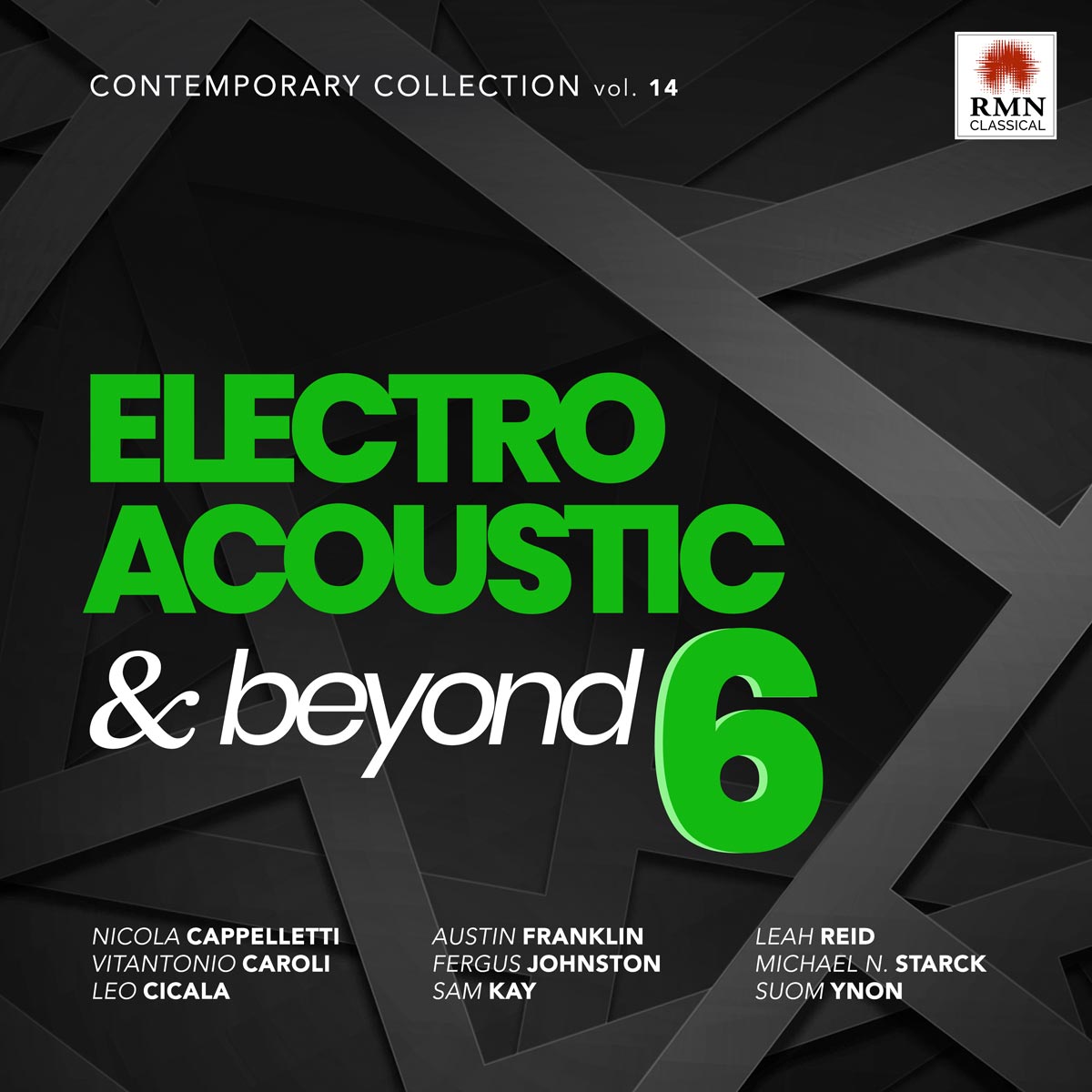MUSIC > Electroacoustic & Beyond 6

Title: Electroacoustic & Beyond 6
Release Date: 19 Nov 2021
Label: RMN Classical
Produced by R. Romano
Cover design by RMN Classical
Electroacoustic & Beyond 6 by Various Artists
| N. | Play | Title | Composer | Time |
| 01 | The Augmentation of Space | Suom Ynon | 03:58 | |
| 02 | Rhythmic Mosaics | Austin Franklin | 06:29 | |
| 03 | In Copula | Sam Kay | 07:31 | |
| 04 | Emma Coulthard’s Planxty | Fergus Johnston | 06:55 | |
| 05 | Reverie | Leah Reid | 10:27 | |
| 06 | Dissipatio HG | Nicola Cappelletti | 09:36 | |
| 07 | Utis | Leo Cicala | 08:18 | |
| 08 | Ascèse | Michael N. Starck | 06:13 | |
| 09 | In una stridente sofferenza | Vitantonio Caroli | 04:38 |
The Augmentation of Space is an ambient minimalist sound-art work that gains inspiration from Jóhann Jóhannsson’s score for Arrival. In this work, Adeline Yap recreates a mysterious soundtrack that contains unfamiliar sounds as though they originated from a different planet. This experimental work was crafted on a bass guitar to generate an entropy of sonic events that were collectively ordered into a form that blurred the lines between sound design and score. The atmospheric layer is comprised of a low drone from a glass slide and reverb from string scratches and harmonics, utilised in their original form, in reverse and with other effects so that every harmonic has its own unique quality and distinct characteristic.
Rhythmic Mosaics is a piece for marimba, vibraphone, and live electronics that is inspired by abstract geometric (or pattern-based) visual art, where numerous small shapes and patterns are combined and arranged to construct larger forms. The piece borrows from this art form by taking several small motivic figures while creating patterns from overlapping simple and compound meters to continuously develop musical textures and harmonies. The electronic component accentuates this effect by creating new patterns and timbres derived from each performer’s component parts.
This composition wants to produce a musical representation of Swiss painter and former Bauhaus art teacher Paul Klee’s painting In Copula (1931). Klee’s painting was heavily influenced by music, and much of his work was an attempt to translate musical ideas (polyphony, harmony, rhythm) into static form in his paintings. This work is an attempt to reimagine this painting in musical form based on the composer's visual experience of the work to carry on the visual music tradition of which Klee was a pioneer, translating the forms and textures in multiple dimensions over time through a combination of harmonic resonant tones, textures and sonic forms.
“Emma Coulthard’s Planxty” (or “Planxty Emma Coulthard”) is a short piece commissioned by Artsada Ltd for Emma Coulthard in 2017. It asks for a glissando head joint (of the kind developed by flautist Robert Dick) to be used for slide effects. The electronics part, created in the “Kenaxis” software environment, is derived from pre-recorded samples of Emma Coulthard’s playing, manipulated using delay, granular synthesis, and distortion of pitch and timbre. The piece is based on a set of variations on a theme, heard at the outset, derived from the letters of Emma Coulthard’s name mapped onto a chromatic scale. A “planxty” in Irish folk music was a type of piece usually composed for harp in tribute to the nominee.
Reverie is an acousmatic composition that leads the listener through an immersive fantasy centered around deconstructed music boxes. The work comprises eight sections that alternate between explorations of the music boxes’ gears and chimes. In the work, the music boxes’ sounds are pulled apart, exaggerated, expanded, and combined with other sounds whose timbres and textures are reminiscent of the original. As the piece unfolds, the timbres increase in spectral and textural density and the associations become more and more fantastical. Gears are transformed into zippers, coins, chainsaws, motorcycles, and fireworks, and the chimes morph into rainstorms, all sizes of bells, pianos, and more.
Dissipatio HG is an homage to the same title post-apocalyptic novel by Guido Morselli, published posthumously in 1977 and written shortly before his death by suicide, which is also the theme of the novel: the dissipation of the entire human race is the sudden and unexpected context in which the suicide loses meaning. Only audiovisual residuals and mechanical devices remain to testify the past existence of mankind, in a mediated new relation with the world where the concepts of time, space and language are newly defined paradigms. The piece reveals a sound dramaturgy, a search for a relationship and for a new language in which the voice of the bass clarinet tries to reconstruct his self-awareness in a context of illegible signals and disregarded responses, where the electronics shape the perception of time, and the accidental synchronicities are nothing more than a lack of mimesis of residual and no longer present sounds. The dissipation of the sound matches the loss of direction, emphasized by the sound degradation processes and the diffusion through transducers applied to steel cans, which flank the more canonical diffusion of electronics.
Utis is based on a mirror game between the voice of the violin and its electronic alter egos. An artificial dialogue is established, in some places in canon, which although uses lyrical gestures does not give way to singing and does not seek an immaculate aura. The violin's voice, more spoken than sung, is offered more degrees of freedom by the score and in the second part, it is entrusted with the control of the punctilious aleatory nature. As in a radio drama, the instrumental part, through a dialogue that is first relaxed and then excited, finds "sound subjects" in the background that welcome and relaunch the voice and sometimes the lament of the solo instrument in the magical three-dimensional environment of the work. The electronics determine the colour and emotional temperature of the two parts of the composition, the background is an active part: it stretches, shatters, expands, explodes and often makes dramatic contact with the figures played by the violinist.
Ascèse is an electroacoustic piece composed in 2021 and based on several electronically generated textures that are merged with a fragmented city soundscape from Berlin and chopped up speech samples. The compositional interweaving of electronic and organic (pre-recorded) source material in Ascèse is similar to a dialectical process. The familiar is being strongly deconstructed, e.g. by means of granular wave manipulation, letting it evolve into abstract formal units just like the electronic material, detached from a natural origin, yet containing a natural timbre. This way, artificial and natural sounds converge to a musical synthesis, encrypted by the piece’s immanent sound language. Using dense layerings of interacting sonic events and various forms of sound granulation and remix effects, transcending existing samples and textures into wide and abstract gestures, the composition becomes also a study on time, dimension and microstructure.
In una stridente sofferenza is an imaginary journey to discover the ancestral origins of Art. The strident sounds suggest to the listener the composer's answer on the genesis of artistic creation: "At the end of the path between truth and deception, there is only one solution: Art is Suffering."

